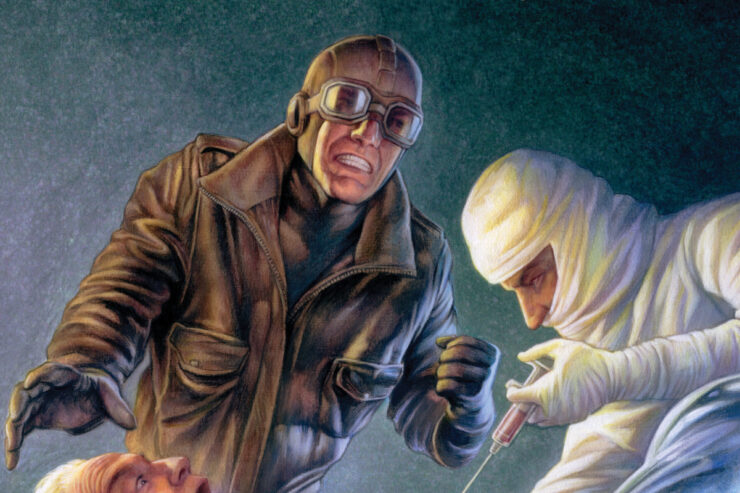Pulp magazines have influenced writers, artists, film directors, software developers, and countless others over the years. Our “PulpFest Profiles” focus on contemporary creators who have drawn inspiration from these rough-paper fiction magazines.
William Patrick Maynard (WPM): Thanks for talking with PulpFest, John. How did you come to know and love the pulps?
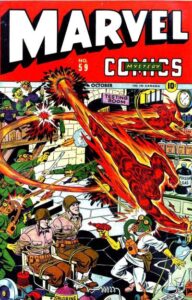 John C. Bruening (JCB): My affinity for the pulps and other forms of popular entertainment from the 1930s and 1940s goes back to my father. He was born in 1929, so his childhood and adolescence were defined by the Great Depression and World War II. He grew up reading the classic adventure stories of Robert Louis Stevenson, Alexandre Dumas, and Edgar Rice Burroughs. His tastes in pulp fiction leaned toward Amazing Stories and other science fiction titles. He read the Golden Age Marvel Mystery Comics, featuring the early stories of the Human Torch, the Sub-Mariner, and, later, Captain America. He was an avid fan of radio drama, especially The Lone Ranger. He loved westerns and cliffhanger serials as well.
John C. Bruening (JCB): My affinity for the pulps and other forms of popular entertainment from the 1930s and 1940s goes back to my father. He was born in 1929, so his childhood and adolescence were defined by the Great Depression and World War II. He grew up reading the classic adventure stories of Robert Louis Stevenson, Alexandre Dumas, and Edgar Rice Burroughs. His tastes in pulp fiction leaned toward Amazing Stories and other science fiction titles. He read the Golden Age Marvel Mystery Comics, featuring the early stories of the Human Torch, the Sub-Mariner, and, later, Captain America. He was an avid fan of radio drama, especially The Lone Ranger. He loved westerns and cliffhanger serials as well.
Thirty-five years later, I was growing up in the 1970s and consuming the prevailing pop culture of my own generation. While I was watching and reading all of that in the 1970s, my dad was pulling back the curtain on a grainy, black-and-white alternate universe of pop culture that most kids my age had no knowledge of. By the time I was 15 or 20, I knew more about The Shadow, Doc Savage, Tarzan, old-time radio, and Republic serials than any of my contemporaries. And I could recognize the threads that connected the various characters and stories of my dad’s era to those in mine.
WPM: Tell us how Flinch! Books came about and how it quickly rose to the heights of being a major player in today’s pulp market, publishing titles as attractive and professional as the best of the best in the field.
John Bruening: When I joined Jim Beard, he was in the home stretch of publishing the first book under the Flinch! Books imprint in 2014. He realized that publishing anthologies was more than he had bargained for in terms of workload and logistics. He asked me if I would be interested in joining him as a partner in the venture. When he said Flinch! could be a platform for any fiction projects that I might want to publish, I was sold. So, we officially announced ourselves as the co-founders of Flinch! Books in January 2015.
We have consistently focused on quality over quantity. We are a two-man operation with full-time jobs and other responsibilities. We do not have the bandwidth to produce more than two or three titles a year. Quality takes time, and it involves a lot of moving parts from conception to production. It also involves writers, artists, and one very skilled graphic designer who give their all every time we call on them. We are eight years and a dozen books into this venture, and we take considerable pride in what we have done so far.
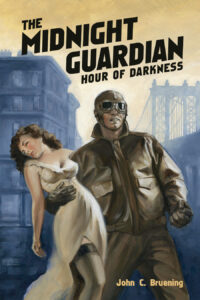 WPM: What about John Bruening, the author? You came out of nowhere in 2016 and knocked readers for a loop with an epic pulp novel of a very rare quality. Did you always want to write fiction? Your books burn with indignation and rage that suggests a life that has known its fair share of frustration and injustice. I put down the first Midnight Guardian and thought Bruening is righting wrongs while writing wrongs. How do you view your creative development?
WPM: What about John Bruening, the author? You came out of nowhere in 2016 and knocked readers for a loop with an epic pulp novel of a very rare quality. Did you always want to write fiction? Your books burn with indignation and rage that suggests a life that has known its fair share of frustration and injustice. I put down the first Midnight Guardian and thought Bruening is righting wrongs while writing wrongs. How do you view your creative development?
JCB: I did about 15 years of newspaper and magazine journalism after college, and I started to realize at that time that writing had become something more than a skill. It was my superpower. It was the one weapon in my arsenal that never failed me. I may not have been a Pulitzer candidate at any point, but I knew how to tell stories that could connect with readers (and I have a couple of awards from the Society of Professional Journalists to prove it). So by the time I reached my early thirties, I stepped back and realized that this was who I was and this was what I was supposed to be doing.
I later transitioned into marketing, and I’ve been successful at that too. But through it all, writing fiction was the last frontier, the territory I had yet to explore.
A recurring theme that runs through the work of my favorite writers is the lone hero facing ridiculous odds who digs deep and draws upon a combination of physical skills and mental resources to save the day, save the city, and save the world. When I started getting serious about writing fiction, these were the kinds of stories I wanted to tell.
Do I write about and for the underdog? Yes, I do and I always will. I want to write about the guy who may stumble at first, but who ultimately beats the odds and surprises everyone who bets against him — and yet maintains his humility and his humanity in spite of his victories. It’s the story I’m consistently drawn to, as both a reader and a writer. I feel like I know that guy pretty well.
WPM: Straight off the bat, apart from the amazing book design, what struck people about your first two Midnight Guardian titles was their epic length. Plenty of authors fill their page count with pointless scenes that truly needed pruning, but the Midnight Guardian books kept me turning the page until you reached the ending leaving the reader desperate to know what happened next. This latest title is decidedly shorter. Was that by design or did this story simply tell itself in fewer scenes?
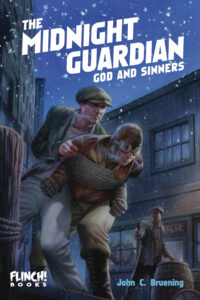 JCB: The third Midnight Guardian book, God and Sinners, is shorter by design. The story is set during the days leading up to Christmas Eve 1938. While the kidnapping of a young boy is certainly a serious criminal offense, I wanted to tell a story whose scope was a little less epic than the two previous ones. No maniacal crime lords threatening to blow up the entire city, and no evil Nazi scientists threatening to turn it to dust with a doomsday weapon. I wanted to bring together people from different walks of life — wealthy and destitute, Christian and Jewish — and see how and where they might find common ground in a time of crisis within a city and uncertainty around the world.
JCB: The third Midnight Guardian book, God and Sinners, is shorter by design. The story is set during the days leading up to Christmas Eve 1938. While the kidnapping of a young boy is certainly a serious criminal offense, I wanted to tell a story whose scope was a little less epic than the two previous ones. No maniacal crime lords threatening to blow up the entire city, and no evil Nazi scientists threatening to turn it to dust with a doomsday weapon. I wanted to bring together people from different walks of life — wealthy and destitute, Christian and Jewish — and see how and where they might find common ground in a time of crisis within a city and uncertainty around the world.
To your point about the length of my previous books, I reject the notion that modern-day pulp fiction must slavishly adhere to specific conventions and parameters established last century. The contemporary reader is accustomed to a more sophisticated level of storytelling in terms of plotting, character development, dialogue, pacing, etc. If it takes a few more pages to do that, then so be it.
WPM: I wanted to make sure we discuss the sheer variety of anthologies Flinch! Books has published. There are no repeats nor have you published public domain characters or licensed properties or reprints from the Golden Age. Is this a deliberate decision to set Flinch! Books apart?
JCB: I wouldn’t say it’s a deliberate decision, but rather it’s just the way things have gone in the eight years that we’ve been doing this. I think we both feel like there are plenty of genres and themes and concepts that are yet to be explored, so we’re not in a hurry to double back just yet. But over the next eight years, I wouldn’t rule out the possibility of revisiting territory we’ve previously covered.
As for public domain characters, I feel like just about every single one to come out of the first half of the 20th century has been done – and done extensively, by multiple writers and publishers in multiple volumes over the last ten or twelve years. So I don’t know how likely we are to go there. And as for licensed properties, we’re certainly open to that. There are plenty of characters and intellectual properties that we’d love to explore, but the likelihood of actually securing those rights would depend on whatever kind of arrangement could be made. In many cases, IP owners are extremely cautious about licensing deals – as they should be – and negotiations can get bogged down in red tape. We have to ask ourselves whether we have the time or the energy for that.
WPM: I am curious if you and Jim consciously set about engendering a creative environment for the writers you work with on your anthologies.
JCB: We want to publish books at the highest level of quality possible, but we also want the editing process to be as collaborative as possible. If a writer submits a story to us and it adheres to the basic established rules of grammar, punctuation, spelling, etc., that’s already a big leap forward. That requires a lot less time and results in far fewer headaches. As long as the writer has a handle on those basic mechanics, and as long as they’ve constructed a story with a solid, plausible plot – or at least plausible within the story’s internal logic – then we’ll do our best to preserve their voice and their intent as much as possible.
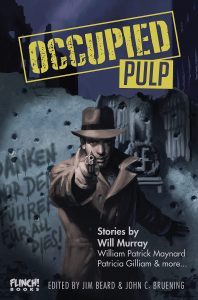 And honestly, it’s in our best interest to be easy to work with. If word gets around that we take an even-handed and collaborative approach, then the greater the likelihood that we can continue to attract good writers. We had the good fortune of working with Will Murray on the Occupied: Pulp anthology in the summer of 2021. Will’s credentials as a pulp fiction writer are pretty hard to beat, so we were pretty happy when he expressed an eagerness to contribute a story to that book. Having a writer of Will’s caliber among our list of contributors might enhance our credentials when we approach other writers about future projects.
And honestly, it’s in our best interest to be easy to work with. If word gets around that we take an even-handed and collaborative approach, then the greater the likelihood that we can continue to attract good writers. We had the good fortune of working with Will Murray on the Occupied: Pulp anthology in the summer of 2021. Will’s credentials as a pulp fiction writer are pretty hard to beat, so we were pretty happy when he expressed an eagerness to contribute a story to that book. Having a writer of Will’s caliber among our list of contributors might enhance our credentials when we approach other writers about future projects.
WPM: John, what other ambitions do you yet hope to fulfill? What is next in the pipeline from John Bruening in 2023 and beyond?
JCB: Flinch! Books is planning an anthology in a genre that is new to us. We’re still working out the details, but I imagine we’ll be able to talk more about it sometime in the first quarter of 2023. I will also be going off the Flinch! reservation for a bit to contribute a story to a western anthology that Charles Millhouse is planning to publish through his Stormgate Press imprint next summer. You may see one or two other stories from me in other non-Flinch! publications.
Beyond 2023, I’d like to develop another series or two in tandem with the Midnight Guardian saga. There were so many fascinating turning points throughout the twentieth century. Any one of them could serve as an excellent backdrop for interesting fiction. In the end, I’m open to any opportunities – either the ones that I can create for myself or the ones that sometimes come my way unexpectedly.
WPM: John, you embody the best the pulp community has to offer. You bring integrity, good humor, and passion to every conversation, every panel, every anthology you edit and publish, and every novel you author. You represent hope for creative expression and reward for dedication and perseverance. The success story that is Flinch! Books and John Bruening the author could not have happened to a nicer guy. Thank you, and all the best to you and Jim and the future of Flinch! Books.
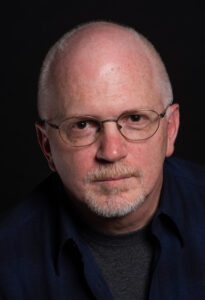 John C. Bruening and Jim Beard are the co-founders of Flinch! Books, publisher of Bruening’s critically acclaimed Prohibition-era pulp hero series Midnight Guardian that began with 2016’s Hour of Darkness and 2019’s Annihilation Machine and continues with 2022’s God and Sinners. Bruening has also co-edited Flinch! Books’ adventure, horror, science fiction, neo-noir, and sword & sorcery anthologies Big Top Tales, Restless, Quest for the Space Gods, Occupied: Pulp, and Blood on the Blade. A 37-year writing professional with a background in journalism and marketing, Bruening found his niche in evoking the pulp classics of yesteryear.
John C. Bruening and Jim Beard are the co-founders of Flinch! Books, publisher of Bruening’s critically acclaimed Prohibition-era pulp hero series Midnight Guardian that began with 2016’s Hour of Darkness and 2019’s Annihilation Machine and continues with 2022’s God and Sinners. Bruening has also co-edited Flinch! Books’ adventure, horror, science fiction, neo-noir, and sword & sorcery anthologies Big Top Tales, Restless, Quest for the Space Gods, Occupied: Pulp, and Blood on the Blade. A 37-year writing professional with a background in journalism and marketing, Bruening found his niche in evoking the pulp classics of yesteryear.
Marvel Mystery Comics was the first comic-book series published by Timely Comics, the company that would later become Marvel Comics Entertainment. The 59th issue of the comic book — dated October 1944 — featured cover art by Alex Schomburg.
The Midnight Guardian: Hour of Darkness, published in 2016, featured cover art by Thomas Gianni. The late artist is well remembered for his dust jacket art for the four-volume Fists of Iron series, published by the Robert E. Howard Foundation, and other work.
Chicago artist and illustrator Douglas C. Klauba contributed the cover art for John Bruening’s second and third Midnight Guardian books, Annihilation Machine and God and Sinners. Doug will be the subject of our next PulpFest Profile.
Occupied Pulp, published in 2021 by Flinch! Books and edited by Jim Beard and John C. Bruening, features cover art by Adam Benet Shaw. The anthology features work by Justin Bell, John C. Bruening, Patricia Gilliam, William Patrick Maynard, Will Murray, and Bobby Nash.
William Patrick Maynard is the licensed continuation author for the Sax Rohmer Literary Estate. His short fiction has been published in anthologies by Airship 27, Bold Venture Press, Black Coat Press, Flinch Books, MX Books, Riviere Blanche, and Titan Books. He has authored over 250 articles for numerous magazines and websites. He has contributed Blu-ray commentary tracks and produced bonus features for releases by MGM, Shout Factory, Kino Lorber, and The Serial Squadron. Bill is on the editorial board of The Battered Silicon Dispatch Box and is a member of the PulpFest Organizing Committee where he serves as Assistant Director of Marketing and Afternoon Programming Director. He resides in Northeast Ohio and regularly contributes to our website. Bill was the subject of our PulpFest Profile for December 12, 2022.
Watch for our next PulpFest Profile in February when Craig McDonald — creator of The Adventures of Zana O’Savin adventure series — will talk with Chicago-based artist and illustrator Doug Klauba.

